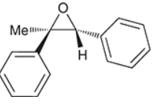
(a)
Interpretation: A starting material and reagents used to form following epoxide needs to be identified.

Concept introduction:
Preparation of epoxide-

Peroxy acids generally used in this process are MCPBA and peroxyacetic acid. Formation of epoxide via peroxy acid us a stereospecific process thus, cis substituents in alkene (starting material) remain at cis to each other in the epoxide (product). Similarly, trans substituents in alkene remain at trans to each other.
(b)
Interpretation: A starting material and reagents used to form following epoxide needs to be identified.

Concept introduction:
Preparation of epoxide- Epoxides can be prepared using peroxy acids. Alkenes are starting material in the preparation of epoxides with peroxy acids. Here, general reaction is represented as follows:

Peroxy acids generally used in this process are MCPBA and peroxyacetic acid. Formation of epoxide via peroxy acid us a stereospecific process thus, cis substituents in alkene (starting material) remain at cis to each other in the epoxide (product). Similarly, trans substituents in alkene remain at trans to each other.
(c)
Interpretation: A starting material and reagents used to form following epoxide needs to be identified.

Concept introduction:
Preparation of epoxide- Epoxides can be prepared using peroxy acids. Alkenes are starting material in the preparation of epoxides with peroxy acids. Here, general reaction is represented as follows:

Peroxy acids generally used in this process are MCPBA and peroxyacetic acid. Formation of epoxide via peroxy acid us a stereospecific process thus, cis substituents in alkene (starting material) remain at cis to each other in the epoxide (product). Similarly, trans substituents in alkene remain at trans to each other.
(d)
Interpretation: A starting material and reagents used to form following epoxide needs to be identified.

Concept introduction:
Preparation of epoxide- Epoxides can be prepared using peroxy acids. Alkenes are starting material in the preparation of epoxides with peroxy acids. Here, general reaction is represented as follows:

Peroxy acids generally used in this process are MCPBA and peroxyacetic acid. Formation of epoxide via peroxy acid us a stereospecific process thus, cis substituents in alkene (starting material) remain at cis to each other in the epoxide (product). Similarly, trans substituents in alkene remain at trans to each other.
Want to see the full answer?
Check out a sample textbook solution
Chapter 13 Solutions
ORGANIC CHEMISTRY- NEXTGEN PACKAGE
- Show the mechanism steps to obtain the lowerenergy intermediate: *see imagearrow_forwardSoap is made by the previous reaction *see image. The main difference between one soap and another soap isthe length (number of carbons) of the carboxylic acid. However, if a soap irritates your skin, they mostlikely used too much lye.Detergents have the same chemical structure as soaps except for the functional group. Detergentshave sulfate (R-SO4H) and phosphate (R-PO4H2) functional groups. Draw the above carboxylic acidcarbon chain but as the two variants of detergents. *see imagearrow_forwardWhat are the reactions or reagents used? *see imagearrow_forward
- The two pKa values of oxalic acid are 1.25 and 3.81. Why are they not the same value? Show the protontransfer as part of your explanation. *see imagearrow_forwardасть Identify all the bonds that gauche interact with C-OMe in the most stable conformation of the above compound.arrow_forwardPredict the reactants used in the formation of the following compounds using Acid-Catalyzed dehydration reactionarrow_forward
- Can I please get help with this?arrow_forward.. Give the major organic product(s) for each of the following reactions or sequences of reactions. Show ll relevant stereochemistry [3 ONLY]. A H Br 1. NaCN 2 NaOH, H₂O, heat 3. H3O+ B. CH₂COOH 19000 1. LiAlH4 THF, heat 2 H₂O* C. CH Br 1. NaCN, acetone 2 H3O+, heat D. Br 1. Mg. ether 3. H₂O+ 2 CO₂ E. CN 1. (CH) CHMgBr, ether 2 H₂O+arrow_forwardAssign this COSY spectrumarrow_forward

 Organic ChemistryChemistryISBN:9781305580350Author:William H. Brown, Brent L. Iverson, Eric Anslyn, Christopher S. FootePublisher:Cengage Learning
Organic ChemistryChemistryISBN:9781305580350Author:William H. Brown, Brent L. Iverson, Eric Anslyn, Christopher S. FootePublisher:Cengage Learning

